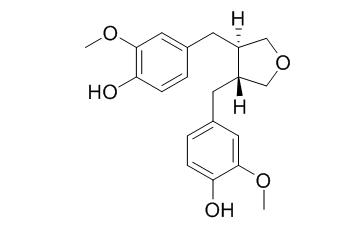Anhydrosecoisolariciresinol
Anhydrosecoisolariciresinol can significantly decrease the growth of human breast cancer MCF-7 and MDA-MB-231 cell lines at 50 and 100 microM.
Inquire / Order:
manager@chemfaces.com
Technical Inquiries:
service@chemfaces.com
Tel:
+86-27-84237783
Fax:
+86-27-84254680
Address:
1 Building, No. 83, CheCheng Rd., Wuhan Economic and Technological Development Zone, Wuhan, Hubei 430056, PRC
Providing storage is as stated on the product vial and the vial is kept tightly sealed, the product can be stored for up to
24 months(2-8C).
Wherever possible, you should prepare and use solutions on the same day. However, if you need to make up stock solutions in advance, we recommend that you store the solution as aliquots in tightly sealed vials at -20C. Generally, these will be useable for up to two weeks. Before use, and prior to opening the vial we recommend that you allow your product to equilibrate to room temperature for at least 1 hour.
Need more advice on solubility, usage and handling? Please email to: service@chemfaces.com
The packaging of the product may have turned upside down during transportation, resulting in the natural compounds adhering to the neck or cap of the vial. take the vial out of its packaging and gently shake to let the compounds fall to the bottom of the vial. for liquid products, centrifuge at 200-500 RPM to gather the liquid at the bottom of the vial. try to avoid loss or contamination during handling.
Front Pharmacol.2021, 12:762829.
Foods.2023, 12(19):3647.
Front Pharmacol.2022, 13:972825.
Dent Mater J.2020, 39(4):690-695
J Nat Prod.2015, 78(6):1339-4
Bull. Pharm. Sci., Assiut University2020, 43(2):149-155.
Mol Med Rep.2015, 12(5):7789-95
J Agric Food Chem.2024, acs.jafc.4c01387.
Anesth Pain Med (Seoul).2020, 15(4):478-485.
Cells.2021, 10(10):2633.
Related and Featured Products
Nat Prod Commun. 2013 Mar;8(3):367-72.
Six new phenolic glycosides and a new ceramide from the flowers of Wedelia biflora and their cytotoxicity against some cancer cell lines.[Pubmed:
23678813]
The plant Wedelia biflora has been used in traditional medicine in India and Vietnam to treat various symptoms. However, the chemical composition of its flowers remains mostly unknown.
METHODS AND RESULTS:
Therefore, we now report the isolation and structural elucidation of six new phenolic glycosides {wedebicoside A - F (1-6)} and one new ceramide [wedebiceramide (9)], together with six known compounds, 1-O-(2',4'-diangeloyloxy-beta-D-fucopyranosyl)-6-hydroxythymol (7), 1-O-[2',4'-diangeloyloxy-3'-(3"-angeloyloxy-beta-D-fucopyranosyl)-beta-D-fucopyransyl]-6-hydroxythymol (8), Anhydrosecoisolariciresinol (10), friedeline (11), epifriedelanol (12) and stigmasterol (13) from the flowers of Wedelia biflora. Their structures were established by 1D and 2D NMR spectroscopy, as well as by high resolution ESI-MS analysis and comparison with literature data. The cytotoxic activities against HeLa, MCF-7 and NCI-H460 were evaluated on some purified compounds at the concentration of 100 microg/mL. Compounds 1, 2, 3 and 5 showed strong cytotoxic activities against three surveyed cancer cell lines.
CONCLUSIONS:
Consequently, this study elucidated the phytochemical composition of W. biflora, as well as the potential use of some of the new compounds against some cancers.
J Med Food. 2010 Aug;13(4):834-41.
Extraction of lignans from flaxseed and evaluation of their biological effects on breast cancer MCF-7 and MDA-MB-231 cell lines.[Pubmed:
20553186]
Over the last decade, there has been an increasing interest in using flaxseed (Linum usitatissimum) in diet in order to improve nutritional and health status. Lignans are major components of flaxseed. Therefore an extraction procedure for lignans from flaxseed has been optimized.
METHODS AND RESULTS:
The influence of some parameters was investigated: first the preliminary extraction step with alcoholic solvent, and then the solvent polarity and pH of the extract. All these conditions affected the total lignan content, but the most critical variables were preliminary extraction and solvent polarity. The optimized procedure, consisting of a direct hydrolysis in hydrochloric acid (1 M) at 100 degrees C for 1 hour followed by an extraction with a mixture of ethyl acetate/hexane (90:10 vol/vol), was applied to 340 g of defatted flaxseed and resulted in the isolation of secoisolariciresinol and Anhydrosecoisolariciresinol with a purity of 97% and 98%, respectively, as determined by high-performance liquid chromatography. The ability of these two compounds and that of secoisolariciresinol diglucoside to modulate the growth of human breast cancer MCF-7 and MDA-MB-231 cell lines was assessed.
CONCLUSIONS:
Our results show that lignans modulate development of breast cancer cells. The most intense effect was observed for Anhydrosecoisolariciresinol, which significantly decreased cell growth at 50 and 100 microM.



